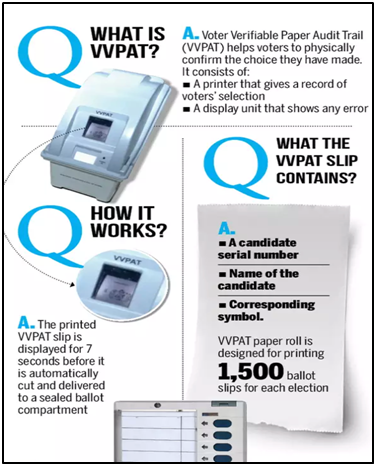What’s in Today’s Article?
- Background (Context of the Article)
- About VVPAT (Meaning, Utility, Working, etc.)
- Auditing of EVMs (Need, VVPAT for Auditing, Criticism of ECI)
- Way Ahead
Background:
- The Election Commission of India (ECI) has attracted criticism for reducing the Voter Verified Paper Audit Trail (VVPAT) based audit of Electronic Voting Machines (EVMs)to an exercise in tokenism.
- Currently, the sample size for auditing the VVPAT accuracy is five polling stations per Assembly Constituency.
- The critics argue that this sample size does not conform to the fundamental principles of statistical sampling and leads to high margins of error.
What is a VVPAT Machine? How does it Work?

- The VVPAT machine is attached to the ballot unit of the EVM, and provides visual verification for the vote cast by a voter by printing a slip of paper with the voter’s choice on it.
- This slip of paper, containing the candidate’s serial number, name, and party symbol, is displayed in the machine behind a glass window. The voter is given seven seconds to verify her vote.
- Following this, the slip falls into a compartment underneath.
- No voter can take the VVPAT slip back home, as it is later used to verify votes cast in five randomly selected polling booths.
- The idea is that by allowing for a physical verification of the electronically cast vote, both voters and political parties have greater faith in the process — that their vote is being recorded correctly.
Need for Auditing of EVMs:
- A defective EVM is defined as one with a mismatch between the EVM count and the VVPAT’s manual count of voter slips due to EVM malfunction or EVM manipulation.
- Unlike industry and trade where a few defectives in the sample may be tolerated, in the context of elections, the acceptance number will have to be ‘zero defective EVM’.
- In other words, even if there is a single instance of mismatch between the EVM count and VVPAT manual count in the randomly drawn sample of EVMs, the ‘population’ of EVMs from which the sample was drawn should be rejected.
- In this case, rejection means non-acceptance of the EVM counts for that population and doing manual counting of VVPAT slips for all the remaining EVMs of that population.
- In such a scenario, the election result should be declared only on the basis of the VVPAT count.
VVPAT-based Audit of EVMs:
- VVPAT-based audit of EVMs involves three essential elements:
- A clear definition of the ‘population’ of EVMs from which the statistical sample would be drawn.
- It could be all the EVMs deployed in an Assembly constituency, a Parliamentary constituency, a State as a whole, India as a whole, a region (or group of districts) within a State, or any other.
- The population size (N) could vary widely depending on how we define the ‘population’;
- Determination of a statistically correct and administratively viable sample size (n) of EVMs whose VVPAT slips will be hand counted;
- Application of the ‘decision rule’.
- In the event of a mismatch between the EVM count and the VVPAT count in the chosen sample of ‘n’ EVMs, the manual counting of VVPAT slips will have to be done for all the remaining (N-n) EVMs forming part of that ‘population’.
Criticism of the ECI:
- The ECI has not specified the ‘population’ to which its sample size relates.
- It has not explained how it arrived at its sample size.
- It has also not explained the ‘next steps’ in the event of a mismatch between the EVM count and the VVPAT count in the chosen sample.
- Hence, these 3 key issues have been left vague or unaddressed.
Way Ahead:
- ‘Plateau Effect’ of sample size can be used to divide the bigger States into ‘regions’ (an integral number of districts) with EVM population sizes of about 5,000 each.
- In this case, “EVMs deployed in the region” can be treated as the ‘population’.
- On average, there would be about 20 Assembly constituencies in a region.
- For example, U.P with 1,50,000 EVMs can be divided into 30 regions with roughly 5,000 EVMs each.
- In the event of a defective EVM turning up, the hand counting of VVPAT slips of the remaining EVMs will be confined to the region.
- This option is statistically robust and administratively viable.
- Meanwhile, the Supreme Court last week said that petitions seeking 100% verification of VVPAT slips would be taken up soon.









